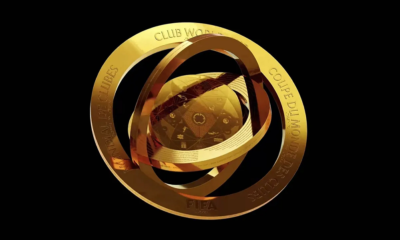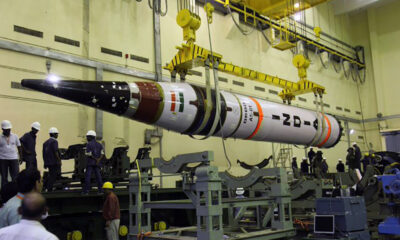Science & Technology
China launches historic mission to retrieve samples from far side of the moon

China on Friday launched an uncrewed spacecraft on a nearly two-month mission to retrieve rocks and soil from the far side of the moon, the first country to make such an ambitious attempt.
The Long March-5, China's largest rocket, blasted off at 5:27 p.m. Beijing time (0927 GMT) from Wenchang Space Launch Center on the southern island of Hainan with the more than 8 metric ton Chang'e-6 probe.
Chang'e-6 is tasked with landing in the South Pole-Aitken Basin on the far side of the moon, which perpetually faces away from the Earth, after which it will retrieve and return samples.
The launch marks another milestone in China's lunar and space exploration programme.
"It is a bit of a mystery to us how China has been able to develop such an ambitious and successful programme in such a short time," said Pierre-Yves Meslin, a French researcher working on one of the scientific objectives of the Chang'e-6 mission.
In 2018, Chang'e-4 gave China its first unmanned moon landing, also on the far side. In 2020, Chang'e-5 marked the first time humans retrieved lunar samples in 44 years, and Chang'e-6 could make China the first country to retrieve samples from the moon's "hidden" side.
FOREIGN PAYLOADS
The launch was attended by scientists, diplomats and space agency officials from France, Italy, Pakistan, and the European Space Agency, all of which have moon-studying payloads aboard Chang'e-6.
But no U.S. organisations applied to get a payload spot, according to Ge Ping, deputy director of the China National Space Administration's (CNSA) Lunar Exploration and Space Program.
China is banned by U.S. law from any collaboration with the U.S. space agency, NASA.
"The far side of the moon has a mystique perhaps because we literally can't see it, we have never seen it apart from with robotic probes or the very few number of humans that have been around the other side," said Neil Melville-Kenney, a technical officer at ESA working with Chinese researchers on one of the Chang'e-6 payloads.
After the probe separates from the rocket, it will take four to five days to reach the moon's orbit. In early June a few weeks later, it will land.
Once on the moon, the probe will spend two days digging up 2 kilogrammes (4.4 lb) of samples before returning to Earth, where it is expected to land in Inner Mongolia.
The window for the probe to collect samples on the far side is 14 hours, compared to 21 hours for the near side.
The samples brought back by Chang'e-5 allowed Chinese scientists to uncover new details about the moon, including more accurately dating the timespan of volcanic activity on the moon, as well as a new mineral.
Ge said the scientific value of Chang'e-6 lay in the geological age of the South Pole-Aitken Basin, which his team estimated was about 4 billion years, much older than the samples previously brought back by the Soviet Union and the United States, which were about 3 billion years old, as well as the 2-billion-year-old samples from Chang'e-5.
LUNAR BASE
Besides uncovering new information about the celestial body closest to Earth, Chang'e-6 is part of a long-term project to build a permanent research station on the moon: the China and Russia-led International Lunar Research Station (ILRS).
The construction of such a station would provide an outpost for China and its partners to pursue deep space exploration.
"We know that the moon may have resources that could become useful in the future, so the European Space Agency, NASA, the Chinese agency and others around the world are going to the moon," said James Carpenter, head of the ESA's lunar science office.
"Part of the rationale is to understand those resources," Carpenter said.
Wu Weiren, chief designer of the Chinese Lunar Exploration Project, speaking at the 2024 China Space Conference last month, said a "basic model" of the ILRS would be built by 2035.
(Reuters)
Science & Technology
South Korea authorities launch probe after three die in Hyundai car test
The Ulsan plant is Hyundai’s biggest manufacturing facility, with its own port and an annual production capacity of 1.4 million vehicles

South Korean authorities launched an investigation on Tuesday after three people died during a car test at a Hyundai Motor plant in the city of Ulsan, police told Reuters.
The two Hyundai researchers and one Hyundai contractor were found unconscious in a car at around 3:00 p.m. while they were testing it in a "chamber," according to Hyundai's labour union.
South Korean media reports said the three had suffocated.
A police officer in Ulsan said the police and the labour ministry were investigating the incident, including its cause.
A fire department official told Reuters that it first received a report at 3:17 pm that the accident happened at Hyundai's No.4 factory.
"Hyundai Motor Company is deeply saddened by the incident that occurred at our plant in Ulsan, South Korea," Hyundai said in a statement, saying it would "cooperate fully with all relevant authorities to determine the cause of this incident."
The Ulsan plant is Hyundai's biggest manufacturing facility, with its own port and an annual production capacity of 1.4 million vehicles, including exports of 1.1 million units.
In November last year, Hyundai Motor broke ground on a 2 trillion won ($1.44 billion) plant in Ulsan dedicated to making electric vehicles in South Korea, as the automaker accelerated a shift away from petrol-powered cars.
[embed]https://youtu.be/KrLKCrpLALU[/embed]
Science & Technology
Russia fines Google more than the world’s total GDP over YouTube bans

Russia has fined Google $2.5 decillion after the US tech giant took action against pro-Kremlin TV channels on YouTube following Moscow’s invasion of Ukraine.
Russia imposed a daily fine four years ago - a fine that has since swelled to an unprecedented level - ($20,000,000,000,000,000,000,000,000,000,000,000 - a 33-digit figure).
To put this into perspective, global GDP reaches an estimated $110 thousand billion (12-digit figure), according to the IMF.
Speaking to Russia’s TASS news agency, one expert, Roman Yankovsky from the HSE Institute of Education, said Google “clearly will not pay this penalty, and the Russian Federation will not be able to recover this money from the company."
Euronews reported that a short calculation shows that he is right.
Google's holding company, Alphabet, has a market capitalisation of slightly more than $2 trillion. Even with earnings of $80.54 billion from the last quarter, the tech giant doesn’t seem to be able to afford to pay the fine.
Google first barred pro-Moscow channel Tsargrad TV, which is owned by oligarch Konstantin Malofeev, four years ago.
At the time, Google was fined a daily penalty of 100,000 roubles and warned that amount would double every 24 hours if it went unpaid.
The original fine has been compounded by further penalties after Google eventually blocked a total of 17 Russian TV channels as a result of international sanctions, The Telegraph reported.
The tech giant now owes a staggering $2.5 decillion.
Science & Technology
Apple launches new iPad mini with AI features
Apple said it would roll out the first set of AI features in the U.S. version of the English language this month through a software update with iPadOS 18.1.

Apple on Tuesday launched its new generation of the iPad mini packed with AI features including writing tools and an improved Siri assistant, as the iPhone maker races to boost its devices with artificial-intelligence capabilities, Reuters reported.
The new iPad mini is powered by Apple's A17 Pro chip, which is used in the iPhone 15 Pro and Pro Max models. With a six-core central processing unit, the A17 Pro would boost CPU performance by 30% compared to the current generation iPad minis and is central to running Apple Intelligence, Apple's AI software.
Apple said it would roll out the first set of AI features in the U.S. version of the English language this month through a software update with iPadOS 18.1.
The features will be available for iPads with A17 Pro or M1 chips and later generations, Apple said, adding it will roll out additional features including image-generation tools, Genmoji and ChatGPT-powered capabilities over the next several months, read the report.
Apple in September unveiled its long-awaited, AI-boosted iPhone 16 lineup, but with the AI features still in test mode, the company failed to excite some investors while early sales data raised some questions around demand.
Still, research firm Canalys on Monday said the iPhone 16 would help Apple's sales in the fourth quarter and drive momentum into the first half of 2025, after Apple reached a record high third-quarter shipments.
The iPad mini, starting at $499, is available for pre-orders starting on Tuesday and will begin arriving to customers and Apple store locations next week, Apple said.
-

 Latest News5 days ago
Latest News5 days agoOttawa taking detention of Canadian in Afghanistan ‘very seriously’
-

 Sport5 days ago
Sport5 days agoFIFA unveils Innovative Club World Cup Trophy ahead of new tournament in 2025
-

 Regional5 days ago
Regional5 days agoIndia’s successful test of hypersonic missile puts it among elite group
-

 Latest News5 days ago
Latest News5 days agoTrump team compiling list of military officers responsible for US withdrawal from Afghanistan
-

 Latest News5 days ago
Latest News5 days agoCanada sent 19 failed asylum seekers back to Afghanistan last year
-

 Sport4 days ago
Sport4 days agoAbu Dhabi’s thrilling T10 tournament just days away
-

 World4 days ago
World4 days agoBiden allows Ukraine to use US arms to strike inside Russia
-

 Sport3 days ago
Sport3 days agoAfghanistan beat UAE by 169 runs in U19 tri-series
























